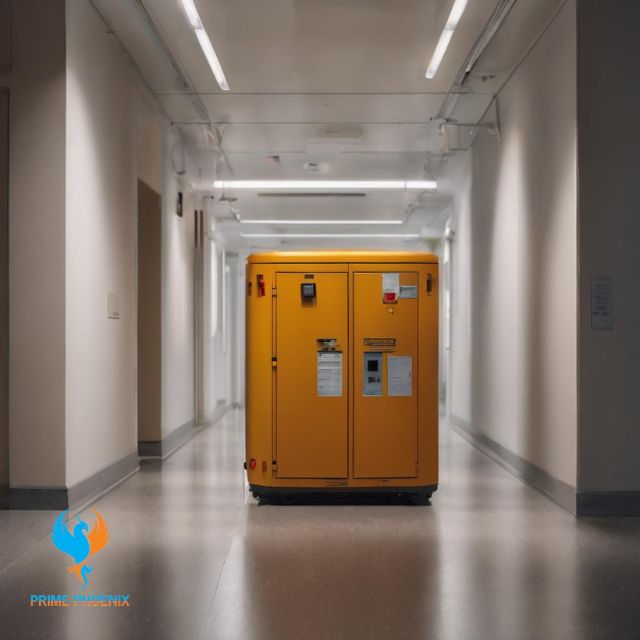- Ras Al Khor Industrial Area 2
- +971 4 330 2170
- +971 547919584
The Importance of Having a Reliable Emergency Lighting System
Emergency lighting systems are a crucial part of any building’s safety infrastructure. When normal power is lost, emergency lights kick in to illuminate paths of egress, allowing occupants to evacuate safely. Emergency lights also help first responders navigate a building during emergencies or power outages.
Choosing the right emergency lighting system for your facility’s unique needs is key to ensuring proper illumination when you need it most. There are several types of systems available, each with their own advantages and considerations. Here is an in-depth look at common emergency lighting options:


Battery-Powered Emergency Lights
Battery-powered emergency lights are self-contained units that switch on automatically when normal power is disrupted. Units contain rechargeable batteries that provide emergency power, typically for 30 minutes to several hours depending on the model.
These emergency lights require no wiring and can be installed quickly and easily. They simply need to be plugged into an electrical outlet to maintain a charge. When power goes out, they activate to provide basic lighting until normal power is restored or batteries run out.
Key Benefits:
- Simple “plug and play” installation
- Can be installed in nearly any location without wiring
- Inexpensive compared to more complex systems
- Provide basic emergency lighting quickly
Potential Drawbacks:
- Limited runtime before batteries are depleted – usually 1-3 hours
- Rechargeable batteries must be replaced every 2-4 years
- May not meet brightness requirements for public buildings
- No remote monitoring – you can’t check battery charge status
Battery units are a good, low-cost option for small offices, retail stores, and residential settings that need temporary emergency lighting. For more robust applications, their lack of brightness and short runtime may be limiting factors.
Generator-Powered Emergency Lighting
Generator-based emergency lighting utilizes onsite diesel or natural gas generators to supply backup power to a building’s normal lighting circuits. When utility power fails, the generator automatically kicks in within seconds to allow full normal lighting functionality.
Generator systems power regular lighting fixtures at typical brightness levels. This allows emergency lighting to match non-emergency conditions in both illuminance and lamp color. Generators can also support other important systems like fire alarms, security lighting, and egress signs.

Benefits of Generator-Powered Lighting:
- Provides normal illumination levels versus dimmer battery-powered fixtures
- Long runtime – 24 hours or more depending on fuel supply
- Can support multiple other building systems, not just lighting
- Very fast activation time when utility power fails
Potential Drawbacks:
- Requires professional installation and maintenance
- Ongoing fuel costs for diesel or natural gas
- Periodic load testing and inspections required
- More expensive than simpler standalone fixtures
For large public venues, hospitals, data centers, and other major facilities where maintaining full lighting during emergencies is critical, generator systems are often the preferred choice. Their high reliability and brightness justify the increased complexity and costs compared to smaller battery-based systems.
Central Battery-Based Emergency Lighting
Central battery emergency lighting utilizes dedicated emergency lighting fixtures connected to large external battery banks that power multiple fixtures across a facility. The emergency fixtures contain internal lamps or LED arrays along with charging and control circuitry.
When activated during an outage, the central battery system powers emergency lighting fixtures at normal brightness levels for 2-4 hours, depending on battery capacity. Fixtures are designed specifically for maintained emergency illumination, unlike regular lighting powered by generators.
Key Benefits of Central Battery Lighting:
- Long runtime from large battery banks – up to 4 hours in many cases
- Lamp heads in fixtures provide bright, focused illumination
- Monitoring and automated testing capabilities
- Centralized system can support multiple emergency fixtures
- Often meets legal requirements for public facilities
Potential Limitations:
- More complex installation with centralized battery bank
- Higher upfront cost than individual battery fixtures -Requires detailed electrical load planning
For large open spaces like auditoriums, warehouses, and factories, a centralized emergency lighting system can provide crucial maintained illumination during extended power outages. Bright lighting and long runtime provide safe working conditions or support orderly evacuation.

Monitored Emergency Lighting Systems
Networked or monitored emergency lighting systems combine centralized battery systems and individual fixtures with centralized control panels and building integration capabilities.
All components have two-way communication with the central control panel. This enables real-time remote monitoring of emergency lighting status across a facility using web or mobile interfaces.
Networked systems provide alerts if any issues arise, such as a failed lamp or low battery. Managers can remotely test emergency lighting and run reports from a laptop or smartphone. Fixtures can also integrate with building management and fire alarm systems.
Key Features of Networked Emergency Lighting:
- Real-time status monitoring and diagnostics for all system components
- Email, SMS, or app alerts for faulty battery or lamp
- Remote testing, reporting and management capabilities
- Integration potential with security, HVAC and fire detection systems
Potential Challenges:
- Highest system complexity of available options
- Requires advanced technical expertise to install and manage
- Carries high upfront cost for hardware and software
For mission-critical facilities, networked emergency lighting provides unparalleled visibility and control. The smart capabilities justify the added complexity for large enterprises that need to centrally manage emergency systems across multiple locations.
Key Factors When Selecting an Emergency Lighting System
Choosing the right emergency lighting system for your needs involves several important considerations:
- Illumination Levels – Centralized battery and generator systems allow for nearly normal lighting levels when activated. Individual battery fixtures provide reduced output. Evaluate required brightness.
- Building/Safety Codes – Public assembly facilities usually require extensive, maintained emergency lighting with specific illuminance rules. Know your local codes.
- Monitoring Needs – Networked systems enable real-time remote monitoring and control but cost more. Simpler systems can’t be monitored remotely.
- Testing and Maintenance – All emergency lighting needs occasional testing and maintenance. Centralized systems make this easier to schedule and manage across multiple fixtures.
- Installation Complexity – Professional installation is recommended for generator and centralized systems. Battery fixtures can often be installed by facility managers.
- Budget – Individual battery units provide basic functionality at a lower upfront cost. Advanced centralized and generator systems offer more capabilities at a higher price point.
Properly installed and maintained emergency lighting provides vital illumination when normal lighting fails. Partner with a trusted supplier and electrical contractor to select a system tailored to your specific requirements. Reach out to Prime Phoenix for help choosing and implementing a code-compliant emergency lighting system that keeps your building safely illuminated 24/7.

